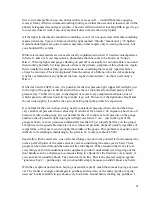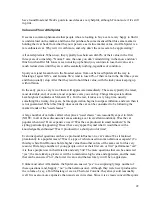
12
according to at least one reliable source, they also lost a certain amount of character (the exact
conversation was, "yeah, they went electronic, but now they drive like Toyotas", to which I
replied, "yeah, but they also start like Toyotas"). While performance didn't increase noticeably at
first, it did at least stabilize and, with the improved driveability of the Bosch systems, made the
cars more fun than their immediate predecessors. Reliability also increased substantially. Indeed,
it often seems that 90% of the problems experienced by Series 3 and 4 owners result mainly from
poor electrical grounds.
In 1981 Alfa also switched the gearing of the rear axle from 4.5 to 4.1. This resulted in an
approximate 400 rpm drop in engine speed at cruise, with the resulting improvement in fuel
economy. However, it also reduced the car
“
s absolute quickness noticeably. Depending on whom
you believe, a limited slip differential probably became standard at this time as well.
In 1983 Alfa introduced the Series 3 car body, the first major revision of the Spider in the US for
eight years, and in Europe the first in twelve.
Because the lion's shares of Spiders have always been sold in the US, and also because Alfa's
financial troubles were beginning to get serious, the company decided to standardize on this body
style. From this point on, European and US Spiders differed very little (although to what extent I
am not certain).
Bumper integration was substantially improved from Series 2a, although still nothing like the
elegance of the early cars, going from the ugly rubber bumpers to somewhat more stylish black
plastic and metal. A prominent lower spoiler was added to the nose, giving it a distinctive "chin"
(and something ELSE to bash on speed bumps and parking stops). Rear bumper integration was
especially good, although a controversial "duck-tail" spoiler marred this integration somewhat.
This item was a soft foam-rubber piece until 1986, when it was redesigned somewhat to
accommodate a third, centrally placed brake light. The material was changed to a hard black
plastic at this time. (special thanks to Stefan Stuerwald for advice on the spoiler)
Due to criticism from the automotive press, and a desire to begin fitting wider tires to the car,
Alfa substantially stiffened the frame of the Spider at this time. However, the cars continued to
be known, and criticized, for their
”
flexible flier
„
chassis. The increased weight also caused
performance to continue to decline.
The interiors were substantially redesigned for the first time since 1971. Although the same dual-
pod dash was retained, the center console underwent several detail revisions, and the rear portion
of the passenger compartment, which before was a basic (if roomy) "well", was flattened,
squared, and made smaller (mainly to accommodate electronics and the new shoulder seatbelt
system).
What was once a very basic, straightforward car was beginning to get quite plush and
complicated. Air conditioning, power windows, power mirrors, and leather upholstery began to
become commonplace.













































